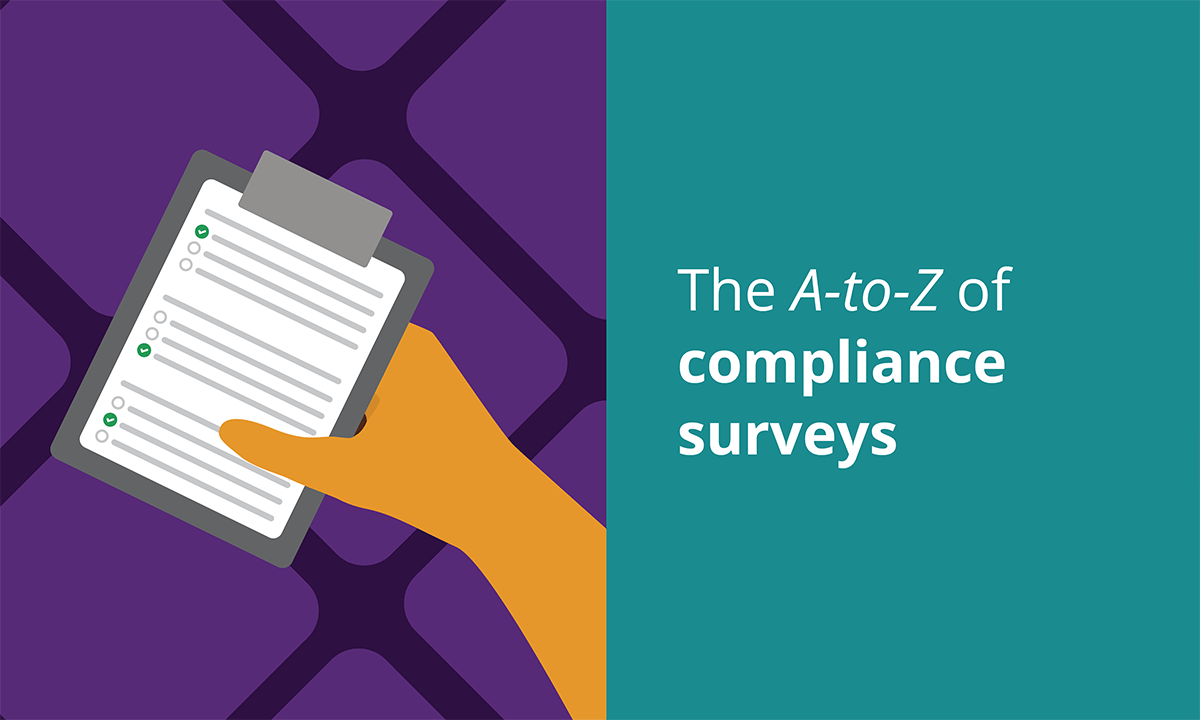
The A-to-Z of compliance surveys
Do you have a pulse on your organization? Knowing what’s going on—and acting on it—not only helps create a speak-up culture, reduces retaliation, improves morale, and shows your employees that you care, it also reduces risks and helps you improve the focus of your training efforts! While the best way to find out what’s going on is to get out there and talk to people, another more formal way is through regular surveys with your employees.
Whether you’re very fortunate and regularly conduct your own compliance survey, or whether you’re allowed a question or two in HR’s culture survey, this two-part blog series will help you get started or improve on getting a pulse on your org through surveys.
(Heads up: This week’s focus is survey development. Next week, we’ll tackle response rates. Stay tuned!)
Form Follows Function
Before you can design your culture survey, you need to know the goal of your survey. Know what you want to find out so you can take action on that information once the results come in.
Not having a goal for your survey is like packing for a vacation without knowing your destination—you’re going to overpack, and ironically, you’ll likely forget something important. ☃️👙☹️
Hot tip! Never conduct a survey just to tell your board you did. Have a plan.

Source: The Oprah Winfrey Show via Giphy.com
Once you’ve got your goal set, draft questions that will help you achieve it. Here are some tips:
- Keep your survey short. Survey fatigue is real. 🥱 (More on this in next week’s post on getting a good response rate.)
- Be precise. Don’t include awkwardly worded questions (“Do you think our leadership team doesn’t respond quickly to concerns?”) or double-barrel questions (“Was your concern handled quickly and respectfully?”). This last type is nearly impossible to answer or analyze correctly—what if the concern was handled quickly but not respectfully? 🤷 Also, don’t ask leading questions that might introduce bias in responses (“How much do you agree that this training was enjoyable?”).
- Limit the number of options. Some researchers insist on having an even number of options, which force people to take sides (“excellent,” “good,” “fair,” and “poor”), while others like an uneven number of options, which allows for people to choose the middle of the scale (rating on a scale of 1 to 5, where 1 is poor and 5 is excellent). ⚖️ There is no right or wrong, but think through what would be the most valuable in your analysis. Also, avoid too many options (e.g. a scale of 1 to 20), as that makes questions more cumbersome to read and answer, and can dilute your analysis. Lastly, make sure your scale is very clearly marked (is a “1” excellent or poor?).
- Stick to mostly closed-ended questions. In other words, use questions that require yes/no answers or scale-type responses. Asking a lot of open-ended questions reduces your response rate, makes it harder to analyze the data, and increases survey time 📉 (both taking and reviewing!).
- Make all questions optional. I know, this is a tough one! 🥺 You want everyone to answer every question. We’ll dive into this more in Part II, as it’s one of the top contributors to response rates.
- Hold demographic questions until the end. 🌎They tend to be more personal, so ease people into the survey before asking those types of questions. (More on this in Part II.)
Now, Test it!
When you think you are done drafting the survey, ask a couple trusted colleagues to take the survey and report back. And don’t just ask if things DON’T make sense; ask for feedback on what works, too! By the way, you’re not off the hook! You should also take the survey yourself.
Friendly pre-launch reminder: Delete test surveys from your data set!
But what should I ask?
Best case scenario: You get the whole culture survey to yourself!
In this situation, you might be tempted to unleash your masterpiece, the 2001: A Space Odyssey of surveys! DON’T!! Keep it short.
Less ideal, but still good: You get one or two questions on a larger culture survey.
Here, use our survey hack! Think hard about what you would like to ask, and look at the rest of the questions to determine if any of them already covers what you want to know. (This is particularly helpful if you get NO questions! Do the best with the info you can get, and hey, maybe someone is willing to tweak their questions to meet both of your needs.)

Thanks for that question on retention, recruiting team! | Source: Cartoon Network's The Eric Andre Show via Giphy.com
Once you know what you’re working with, you can come up with your own original Qs… or find some inspiration from Team Broadcat and friends! Here’s a compilation of some of our favs….
Jennifer May, Director of Compliance Advisory: If a job opening were available in your department (or at our company), would you encourage your best friend to apply? 👯 A "yes" response is good news; a "no" response is not good at all. If your employees don’t want their friends working there, how long do you think they are going to stay?
Jaycee Dempsey, Director of Customer Success: I trust my manager to do the right thing. 💪 Since most employees leave organizations due to their direct manager, a “no” response is an indication that things are not going well and ethics are not being promoted.
Brianna Rice, Customer Success Manager: If you were aware of something that might be inappropriate, would you feel comfortable speaking up to your manager? 📣 This question is another indication of the culture at your organization. If people are not speaking up, your compliance program is not working.
Kitty Holt, Director of Operations (ME!): If you had a concern and spoke up, do you think action would be taken as a result? 🚀 (If the respondent says “no,” or “don’t know” or “it depends,” clarify why.) This question gets to the heart of organizational justice.
Pat Harned, President of the Ethics and Compliance Initiative: I would ask employees about the extent to which they feel pressure to cut corners to do their jobs. ✂️ ECI’s research has shown that when employees indicate that they feel pressure, there is a very high likelihood that they will also observe misconduct happening around them.
On a scale of 1 (not at all) to 5 (totally), how ready are you to survey your employees?
If you’re on the lower end of that scale, that’s OK! You’ve got the question-asking basics, but now you need those pro tips to increase your response rate (hint: we’ll cover that in Part II!). Meet ya’ back here next week!

